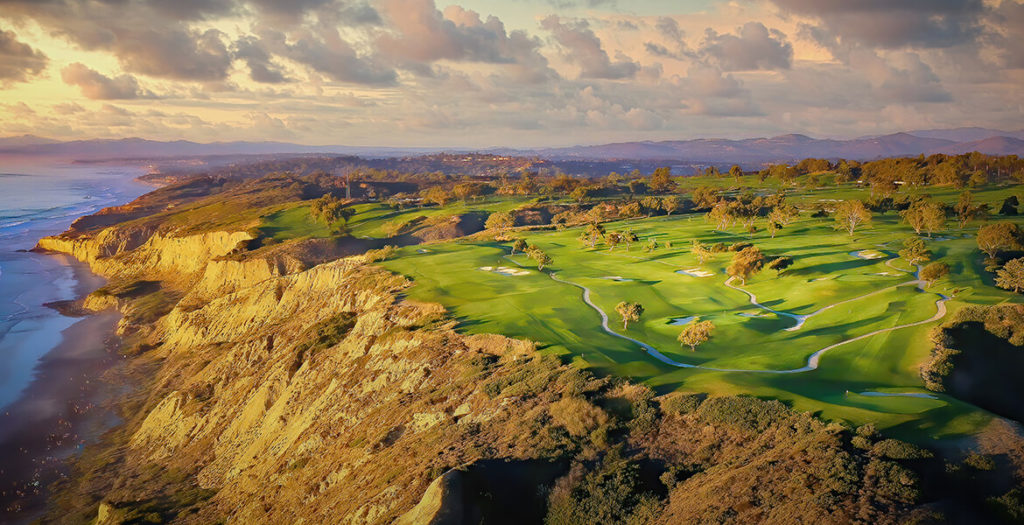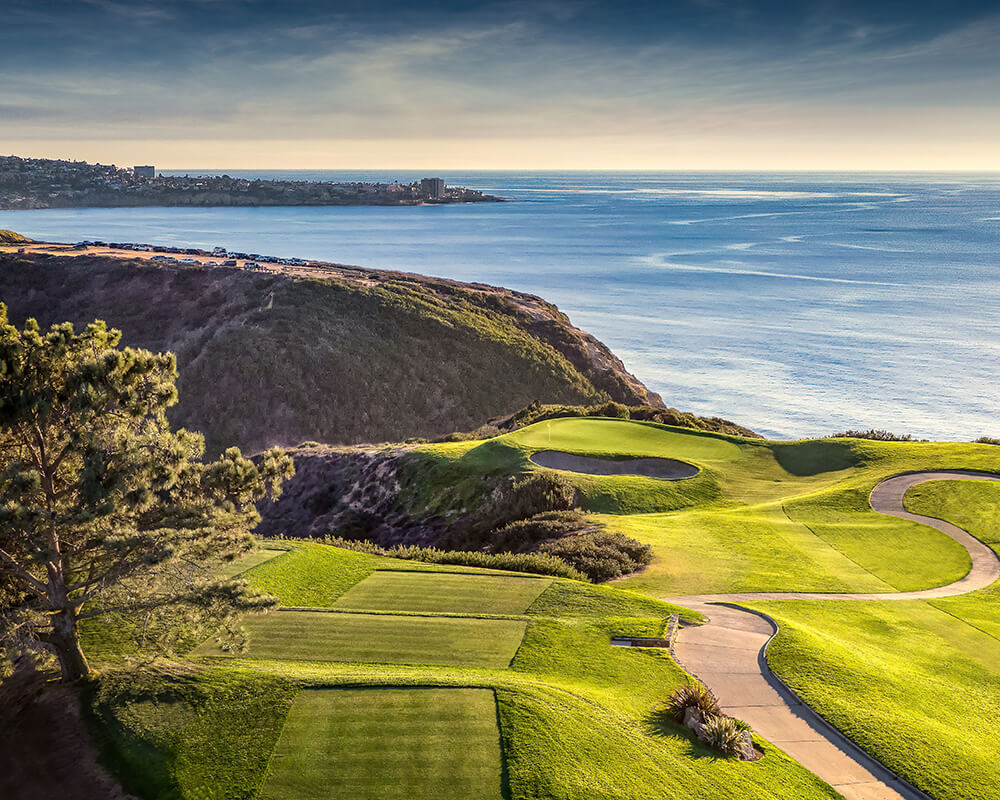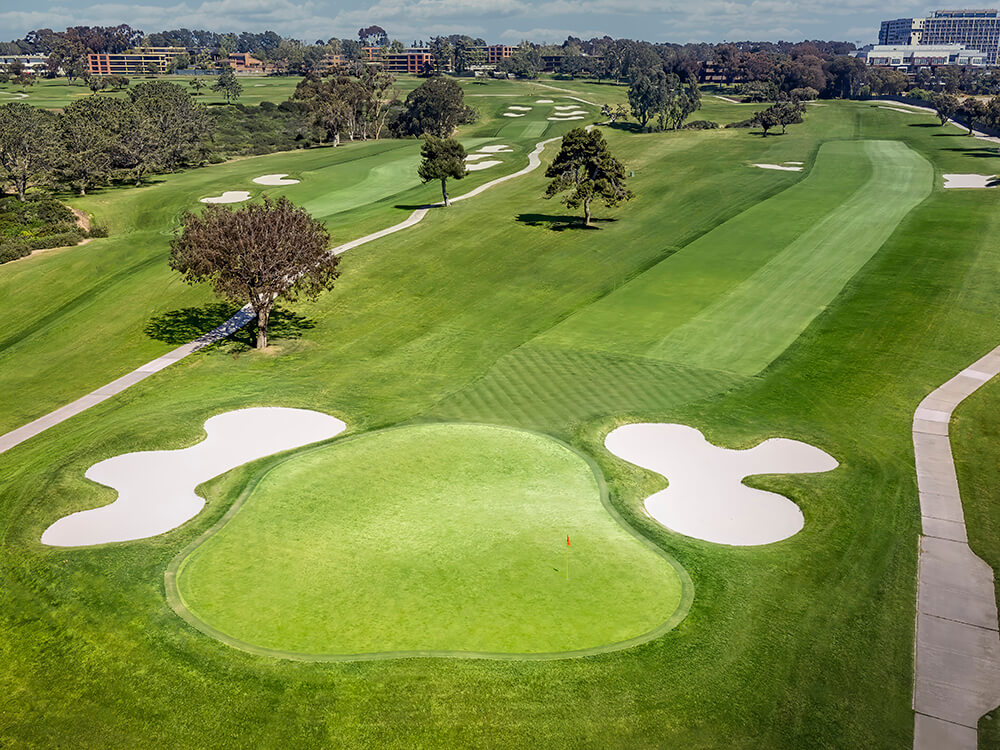The U.S. Open Returns to Torrey Pines South
Joe Passov
Links Magazine
It’s Torrey time again for the U.S. Open.
Torrey Pines’s South course, the most celebrated municipal layout west of the Mississippi, takes center stage in mid-June for the second time. Thirteen years ago, Tiger Woods cemented forever Torrey’s reputation for tournament drama. His clutch 12-foot birdie putt at the par-five 72nd hole and subsequent 18- hole playoff victory—competing on what we learned later was a broken leg—made the 2008 U.S. Open one of the most memorable majors ever. Due to injuries sustained in a February car crash, Tiger won’t be back to defend. He surely would have relished the examination Torrey Pines will present.
Draped atop the oceanside bluffs of La Jolla, Calif., just north of San Diego, the South course opened in 1957 with a William F. “Billy” Bell design. Wildly popular for both its playing and monetary value, the city-owned course began hosting the PGA Tour in 1968.
Following a comprehensive renovation by “Open Doctor” Rees Jones in 2001 that stiffened the challenge considerably, the USGA awarded Torrey Pines a U.S. Open. After Woods’s historic triumph in 2008, there was no doubt that the course would earn another U.S. Open. However, a question remained: Did it deserve one?
“Absolutely,” says Jones. “Being chosen a second time means that it really was regarded by the players and by the USGA as a true championship test.”

Critics chirp that Torrey Pines is a relentless slog in a handsome setting, devoid of risk/reward excitement, with more emphasis on slugging than strategy. Not surprisingly, Mr. Jones, many players, and the USGA disagree.
“The reason Torrey Pines succeeds as an outstanding U.S. Open course, even without the wind,” says Jones “is the green angles, the green contours, the positioning of the bunkers, and the width of the fairways. It fulfills all of the USGA requirements.”
One of those USGA requirements is a renewed emphasis on precision. Gone is the two-decade experiment with graduated rough, which penalized shots to the degree missed. Back in vogue as of 2019 is the more recognizable, somewhat penal old-style setup, with narrow fairways, a slender first cut, and dense rough (four-inch kikuyu at Torrey) snagging wayward shots.
Torrey’s most unsung feature, according to Jones, is the poa greens. Drier weather and the USGA setup lead to firmer and faster greens in June than they are for the Farmers Insurance Open in January, so the targets are squeezed and the challenge is amplified.
“Most of the greens have open entrances,” says Jones, “which is only important to the pros when they’re playing out of the rough. But there are some very good hidden pin positions on these greens. The greens on 1 and 7 are diagonals and we built tongues on 11, 12, and 16. There’s a lot of diversity in the hole locations, where the USGA can make the muscles tighten or allow the players to free-wheel it.”

Jones and colleague Greg Muirhead tweaked the South in 2018–19 with more than $12 million in renovations, installing a modern irrigation system, relocating and rebuilding bunkers, adding tees, and repositioning fairways closer to the canyons, among other changes. The course is much improved, but undeniably tougher.
At the 451-yard, par-four 1st hole, Jones eliminated a right-side fairway bunker and created a new one further up that requires a 326-yard carry. Tiger Woods somehow double-bogeyed the hole in rounds one, three, and four at the 2008 U.S. Open and the task has only become more onerous.
The South isn’t populated with “Dream 18” candidates, but the 201-yard, par-three 3rd and the 490-yard, par-four 4th are bona fide all-stars by any reckoning. The third plunges several stories tee to green and boasts a glorious ocean backdrop. Expect to see the alternate tee of 159 yards used at least once, with players lofting 9-irons or wedges to a tucked hole location.
One of the most significant recent changes took place at the beefy 4th, which is perched on a bluff with the ocean to the left. Jones’s team widened the fairway and regraded it with a right-to-left pitch to bring the cliffs more into play. The back tees were shifted to the west so that drives will hold the fairway only when properly struck. Jones rebuilt the bunker fronting the green, making it smaller. The green can now accommodate run-up approaches from either side of the bunker.
Other major 2019 alterations included adding 38 yards and a risk/reward carry option to the rebuilt left-side fairway bunker at the 454-yard par-four 10th; adding two bunkers in the left side of the driving zone at the 621-yard par-five 13th (a hole that Woods eagled in 2008’s third round while Phil Mickelson made nine); lengthening the par-four 15th 39 yards to 517 yards; and shifting the fairway on the 17th closer to the canyon, following the loss of the course’s namesake pine trees to disease and storm damage.

The 505-yard par-four 12th hole played toughest at the 2008 U.S. Open and bullies the PGA Tour’s best year after year. This straightaway clifftop monster plays uphill and into the wind. Bunkers left and right pinch the landing area, but it’s the approach that sends scores soaring, all carry to a slightly elevated green that’s guarded by a pair of gaping bunkers.
Paradoxically, the easiest hole at Torrey Pines South houses the course’s only water hazard, a pond that fronts the left side of the 18th green. Eight eagles touched down at the 570-yard hole in 2008 and birdies outnumbered bogies by nearly four to one. Look for more fireworks in 2021.
Unquestionably, Torrey Pines South is a fair, stern championship layout. Woods and Rocco Mediate were the only players who finished under par in 2008—by one stroke. For the 2021 U.S. Open, the course will measure about 100 yards longer, close to 7,750 yards. As in 2008, par will be 71, with the 560-yard par-five 6th shortened to a 515-yard par four. With or without wind, a fistful of approach shots will call for mid and long irons, even hybrids, a rarity in the game these days.
Bottom line? Torrey Pines barely resembles a Golden Age classic course, but it definitely presents an old-fashioned U.S. Open test.